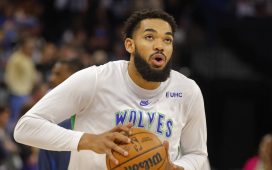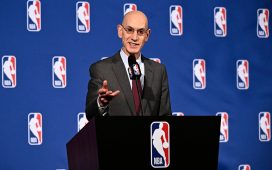The money came in wire transfers, each one a boon for a beleaguered N.C.A.A.
In March, the coronavirus pandemic had eviscerated the Division I men’s basketball tournament, which had been poised to bring in more than $800 million. But by the end of June, N.C.A.A. executives knew that a crucial lifeline, one burrowed in the black-and-white language of five insurance policies, would soon come through: $270 million in cash — among the largest pandemic-related payouts in all of sports.
“It was one of the simpler claims processes,” Brad Robinson, the N.C.A.A. official who coordinates insurance matters, said in an interview in early February, soon after the association acknowledged that insurance proceeds tied to event cancellations accounted for more than half of its revenues during its 2020 fiscal year.
The specialized insurance policies, which cover cancellations because of communicable disease outbreaks, have historically been scarcely noticed but have proved crucial for parts of the sports world to weather the pandemic. Ordinarily products purchased to guard against the financial fallout of terrorism, severe weather and other unexpected setbacks, policies have helped salvage the balance sheets of events as small as local road races to competitions as wealthy and mighty as the sprawling N.C.A.A. tournament.
Now, insurers are bracing to see whether the Tokyo Olympics, already postponed from 2020, will happen, and industry experts said a cancellation would fuel several billions of dollars in losses across a number of organizations.
And with pandemic policies now largely unavailable — or extraordinarily expensive when they can be found — events that did not already have coverage for 2021 may be at risk of financial collapse if they cannot be held.
“If you have a $20 million event, you may only be able to get $1 or $2 million” of it covered for infectious disease, said John Beam, executive vice president for the sports and entertainment practice at the risk management firm Willis Towers Watson and a broker whose clients have included the N.C.A.A., Major League Baseball and the College Football Playoff. “That doesn’t really address what we want.”
Nathan Nicholas, the chief executive of Nicholas Hill Group, a Colorado Springs firm that works on insurance issues with national governing bodies like U.S.A. Fencing and U.S. Rowing, said that a year and a half ago, disease coverage was only sometimes a pivotal concern. “Pandemics,” he said, “were a bit of an afterthought,” so much so that at least one major provider used to offer free coverage for communicable diseases.
Other insurance brokers recalled leagues and events declining to pay for coverage when it was pitched to them, believing the expense was a waste of money.
But even those organizers have for decades been spending on insurance policies that cover other types of worries. Current and former sports executives said they believed the emphasis on far-reaching cancellation insurance policies for athletic events had risen as television rights deals swelled to tens of millions or hundreds of millions of dollars a year.
The N.C.A.A. has been buying coverage for its men’s basketball tournament since the late 1990s, when its annual budget was less than $450 million in today’s dollars. (In its last pre-pandemic fiscal year, the N.C.A.A. reported about $1.1 billion in revenues, including $868 million in television and marketing rights fees.)
“You started to see increases in these media contracts, and it made people realize they needed to protect their revenue streams,” said Kathleen McNeely, the N.C.A.A.’s chief financial officer since 2011.
Underwriters and college sports officials believed there was a very low risk that the tournament, a vast event with games at sites across the United States, would ever be abandoned in its entirety. Trouble in one city, they reasoned, would be unlikely to wipe out all 67 games. And although executives feared something like the coronavirus pandemic, a full cancellation was still seen, over all, as a slim possibility.
“The likelihood of a full event cancellation and the long-term, widespread lockdown that Covid brought was so, so minute, so improbable,” Robinson said, “and that was evident in how the insurers rated the insurance.”
The N.C.A.A. paid a little more than $2 million for $270 million in coverage, a premium in line with the industry’s standard of anywhere from 0.5 percent to 3 percent of the amount covered. The policies backed up a sum roughly equivalent to the tournament’s ticket sales and about one-third of its media rights, which are imperiled when an event is not held.
N.C.A.A. executives and some outside analysts said it would have been too expensive to insure every dollar associated with the tournament — a position some critics have challenged in recent months. And college sports leaders believed that other parts of their emergency plan, including reduced payouts to schools, would keep the group afloat when combined with the insurance coverage.
Before the N.C.A.A.’s Board of Governors voted on March 12 to cancel the tournament — a decision reached during an unnerving conference call when Dr. Vivek H. Murthy, then a board member and now President Biden’s nominee for surgeon general, warned of the uncertainties surrounding the virus — Robinson spoke with the association’s insurers, a common step when a claim might be forthcoming.
With the association’s coverage so far-reaching and the public health crisis so clear, the insurers sought relatively little information to support a nine-figure claim after the board reached its unanimous decision. The first payment, officials said, was wired within 45 days.
Other businesses, including some in the sports industry, have clashed with their insurers over the precise protections of their policies. According to Covid Coverage Litigation Tracker, a University of Pennsylvania law school project, businesses have filed more than 1,400 civil cases over various kinds of policies.
M.L.B. and its clubs are among the litigants, having filed suit in California against three insurers who denied their claims. Experts have since questioned whether baseball had purchased insurance appropriate for a pandemic’s risks, but M.L.B., which otherwise declined to comment, said in a statement that “we strongly believe these losses are covered in full by our insurance policies, and are confident that the court and jury will agree.”
According to its lawsuit, baseball believes it is covered under property damage and business interruption provisions, which experts said differ from the coverage the N.C.A.A. relied upon.
Brokers who regularly work with sports clients said that most teams and leagues had limited coverage and wanted to save money on insurance costs wherever they could.
“From a season-type perspective, no one envisioned ever losing games for an extended amount of time,” Beam, of Willis Towers Watson, said. “Leagues didn’t buy policies for their media rights revenues because they felt, ‘Hey, we will always have content to supply.’”
Insurers generally write event cancellation policies for terms of one to three years. And, to some degree, whether a sporting event is covered for communicable diseases in 2021 comes down to luck. The N.C.A.A. is among the lucky: The association is in the last year of its three-year policy and is covered for the tournament that will be played in Indiana in March and April.
Wimbledon is not: Its coverage expired in 2020, and the tennis tournament’s organizers are not able to include communicable disease in a 2021 policy.
“That’s impossible in the current climate,” Richard Lewis, who recently stepped down as the chief executive of the All England Club, said last summer.
The tournament was covered for 2020, with a policy that included protections for communicable disease outbreaks that reportedly could pay out as much as $140 million. But getting that money was not easy. Wimbledon just finished negotiating with its insurers — 11 months after the 2020 tournament’s cancellation, a spokeswoman for the All England Club said in a statement.
“For a number of years, we have undertaken a risk management process in order to ensure we have understood our risks and are managing them accordingly as best we can,” the spokeswoman said. “This process also informs the insurance provision we put in place, which is reviewed on a regular basis and is something we have prioritized investment in. As a result, we were able to progress with cancellation insurance claims for the Championships 2020, which we have now settled.”
Few, if any, new policies are being written to accommodate potential future claims related to the virus. John Q. Doyle, the president and chief executive of Marsh, a global insurance brokerage firm, warned Congress in November that the industry was “seeing exclusions for communicable diseases coverage going forward” with event cancellation policies after “considerable losses on these policies related to Covid-19.” Brokers said that future policies could include deductibles, which have been rare in the past.
But insurance is typically a coldly rational business that seeks to forecast every eventuality — and capitalize on it. In the past two decades or so, experts noted, the world grappled with an assortment of outbreaks that did not prompt a near-total shutdown of sports worldwide. If pandemics like the current one are seen as a once-in-a-century exception, they said, insurers are likely to look to profit off policies during the other 99 years.
How much — and how soon — insurers are willing to take such risks may depend on what happens with the Olympics this summer.
Although Olympics officials insist the Games will go on as rescheduled in late July and early August, a cancellation would prompt a crush of new claims from the International Olympic Committee, broadcasters and others. Even if they do go forward as scheduled, industry experts said the postponement of the Games from last year very likely prompted hundreds of millions of dollars in losses.
“Everyone is kind of holding their breath,” Nicholas said. “There was plenty of supply and not enough demand a year or two ago.”
Tariq Panja contributed reporting.





